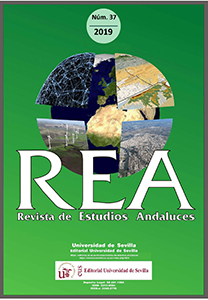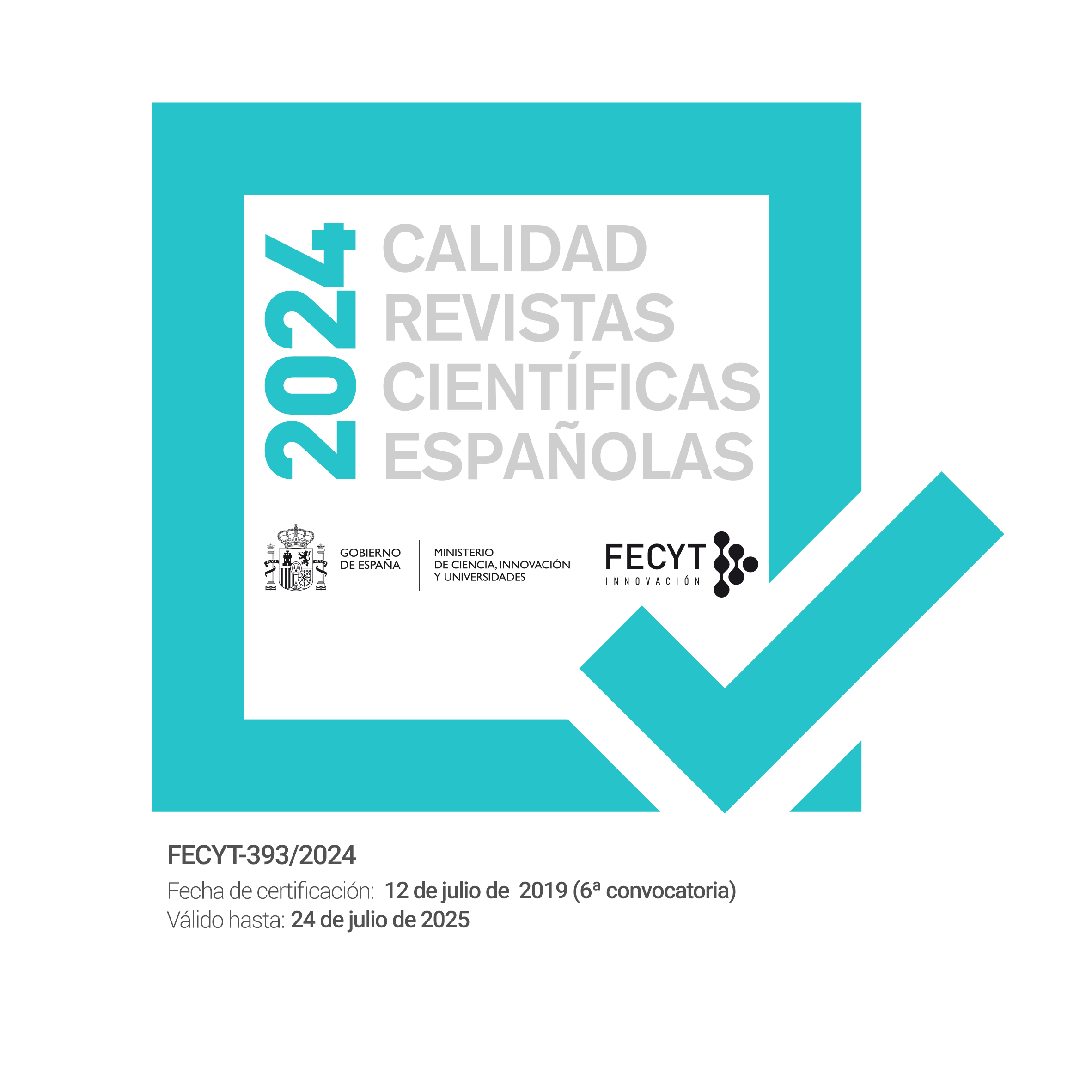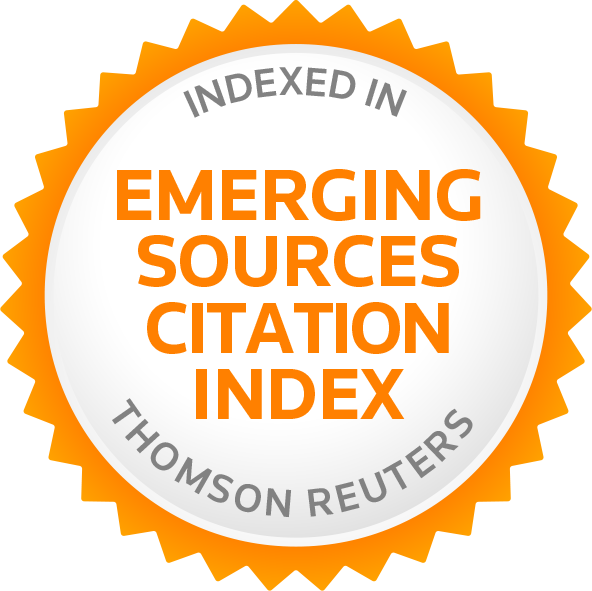Evolución Reciente de los Patrones Espaciales de la Actividad Logística en Contextos Metropolitanos: El Caso de la Región Urbana de Madrid
DOI:
https://doi.org/10.12795/rea.2019.i37.05Palabras clave:
Actividades logísticas, espacio logístico, región urbana, estrategia territorial logística, Región urbana de MadridResumen
La actividad logística se ha estudiado bajo distintas ópticas, pero con escasa atención a sus impactos en la reorganización urbana y territorial. Este trabajo investiga su expansión en la Región Urbana de Madrid, considerando la localización preferente en los espacios suburbanos y rurales del área metropolitana y su polarización geográfica. El método analiza cuantitativamente tres variables que ilustran su difusión espacio-temporal: trabajadores y empresas por municipios, superficie logística por provincias y usos del suelo con aprovechamiento logístico. Los resultados confirman la propagación de la logística en los espacios metropolitanos mediante procesos de suburbanización y dispersión, al tiempo que la aparición de nuevas centralidades urbanas, consecuencia de la mayor integración de las economías capitalistas a distintas escalas
Descargas
Citas
Antón, F. J. (2013). Redes de transporte, articulación territorial y desarrollo regional. Revista de Estudios Andaluces, 30, 27-47. doi: http://dx.doi.org/10.12795/rea.2013.i30.02
Aljohani, K. y Thompson, R. (2016). Impacts of logistics sprawl on the urban environment and logistics: taxonomy and review of literature. Journal of Transport Geography, 57, 257-263. doi: https://doi.org /10.1016/j.jtrangeo.2016.08.009
Allen, J., Browne, M. y Cherrett, T. (2012). Investigating relationships between road freight transport, facility location, logistics management and urban form. Journal of Transport Geography, 24 (4), 5-57. doi: https://doi.org/10.1016/j.jtrangeo.2012.06.010
Ballou, R. H. (1987). Basic Business Logistics, Englewood Cliffs: Prentice-Hall.
Ballou, R. H. (1992). Logistics management. Schoonhoven: Academic Service.
Ballou, R. H. (2004). Logística. Administración de la cadena de suministro, México: Prentice Hall. Pearson Education.
Ballou, R. H. (2007). The evolution and future of logistics and supply chain management. European Business Review, 19(4), 332-348. doi: https://doi.org/10.1108/09555340710760152
Blaik, P. y Matwiejczuk, R. (2009). Logistics processes and potentials in a value chain. Logforum, 5(2), 1-8.
Boudouin, D. (2006). Les espaces logistiques urbains : Guide méthodologique. La documentation française, pour le PREDIT.
Bowen, J. (2008). Moving places: the geography of warehousing in the US. Journal of Transport Geography, 16, 379-387. doi: https://doi.org/10.1016/j.jtrangeo.2008.03.001
Browne, M. (1993). Logistics strategies in the Single European Market and their spatial consequences. Journal of Transport Geography, 1, 2, 75-85. doi: https://doi.org/10.1016/0966-6923(93)90001-G
Bowersox, D. J., Closs, D. J. y Bixby Cooper, M. (2006). Supply Chain Logistics Management. New York: McGraw-Hill/Irwin.
Cuatrecasas, L. y Casanovas, A. (2001). Logística Empresarial. Barcelona: Gestión 2000.
CBRE (2016). Informe logístico. España 2015-2016. Madrid. Recuperado de [3 de abril de 2018].
Chieh-Yu, L. (2008). Factors affecting the adoption of radio frequency identification technology by logistics service providers: an empirical study. International Journal of Management, 25(3), 488-496.
Chopra, S. (2003). Designing the distribution network in a supply chain. Transportation Research Part E: Logistics and Transportation Review, 39(2), 123-140. doi: https://doi.org/10.1016/S1366-5545(02)00044-3
Cidell, J. (2010). Concentration and decentralization: the new geography of freight distribution in US metropolitan areas. Journal of Transport Geography, 18, 363-371. doi: https://doi.org /10.1016/j.jtrangeo.2009.06.017
Cidell, J. (2011). Distribution centres among the rooftops: the global logistics network meets the suburban spatial imaginary. International Journal of Urban and Regional Research, 35(4), 832-851. doi: https://doi.org/10.1111/j.1468-2427.2010.00973.x
CMS (Centre For Maritime Studies) (2005). Case Study on Spatial Planning and Logistic Centres, Work Package 2 Report. Finland: University of Turku.
Combes, F. (2016). Theoretical analysis of the cost structure of urban logistics. 6th International Conference on Information Systems, Logistics and Supply Chain, ILS Conference 2016, June 1- 4. Bordeaux: France.
CSCMP (Council of Supply Chain Management Professionals) (2013). Supply Chain Management terms and glossary. Illinois: Council of Supply Chain Management Professionals – CSCMP. Recuperado de [6 de junio de 2018].
Dablanc, L. y Rakotonarivo, D. (2010). The impacts of logistic sprawl: how does the location of parcel transport terminals affect the energy efficiency of goods' movements in Paris and what can we do about it? Procedia in Social Behavioural Sciences, 2 (3), 6087-6096. doi: https://doi.org/10.1016/j.sbspro.2010.04.021
Dablanc, L. y Ross, C. (2012). Atlanta: a mega logistics center in the Piedmont Atlantic Megaregion (PAM). Journal of Transport Geography, 24, 432-442. doi: https://doi.org/10.1016/j.jtrangeo.2012.05.001
Dablanc, L., Ogilvie, S. y Goodchild, A. (2014). Logistics Sprawl: Differential Warehousing Development Patterns in Los Angeles, California, and Seattle Washington. Transportation Research Record (TRR), 17, 2410, 105-112. doi: https://doi.org/10.3141/2410-12
Dablanc, L. Zeting, L., Koning, M., Klauenberg, J., Kelli, L., Blanquart, C., Combes, F., Coulombel, N., Gardrat, M., Heitz, A. et al (2017). CITYLAB Deliverable 2.1, Observatory of Strategic Developments Impacting Urban Logistics (2017 Version), Report for the European Commission, 222 p. Recuperado de <https://hal.archives-ouvertes.fr/hal-01627824/document> [15 de diciembre de 2017]
De La Torre, I. y Torralba, L. (2017). ARCANO. La disrupción tecnológica ya está aquí. Cómo afecta a las personas, los gobiernos y las empresas. Recuperado de <https://www.arcanopartners.com/sala-prensa/informes-presentaciones/> [8 de julio de 2018].
Del Río, I. y Rodríguez Moya, J. (2008). Áreas metropolitanas en transformación. Presente y futuro del Corredor del Henares en el área funcional madrileña. Anales de Geografía, 29, 1, 139-165
Del Río, I. y Rodríguez Moya, J. (2012). Nuevos espacios para las actividades logísticas. Una revisión crítica para el caso de la Comunidad de Madrid. Ería, 89, 275-290.
De Santiago, E. (2008). El sector logístico y la gestión de los flujos globales en la región metropolitana de Madrid. Scripta Nova, Vol. XII, núm. 259, 1-32.
Diziain, D., Ripert, C. y Dablanc, L. (2012). How can we Bring Logistics Back into Cities? The Case of Paris Metropolitan Area. Procedia - Social and Behavioral Sciences, 39, 267-281. doi: https://doi.org/10.1016/j.sbspro.2012.03.107
European Commission (2006). Freight Transport Logistics in Europe – the key to sustainable mobility, COM (2006) 336 final, 28 June 2006.
European Commission (2008). Statistical coverage and economic analysis of the logistics sector in the EU (SEALS). Final Report. Recuperado de: <https://ec.europa.eu/transport/sites/transport/files/themes/ strategies/studies/doc/2008_12_logistics.pdf> [11 de octubre de 2018].
Ezziane, Z. (2000). Evaluating customer service performance in warehousing environments. Logistics Information Management, 13(2), 80-93. doi: https://doi.org/10.1108/09576050010314027
Frago i Clols, L. (2015). Logística y reestructuración metropolitana en el área de Barcelona. Scripta Nova, Vol. XIX, núm. 523, 1-25.
Giuliano, G., Kang, S. y Yuan, Q. (2016). Spatial Dynamics of the logistics industry and implications for freight flows. A research report from the National Center for Sustainable Transportation. METRANS. Sol Price School of Public Policy, University of Southern California.
Guoqi, L., Fengjun, J., Yu, Ch., JinJuan, J. y Sijing L. (2017). Location characteristics and differentiation mechanism of logistics nodes and logistics enterprises based on points of interest (POI): A case study of Beijing. Journal of Geographical Sciences, 27 (7), 879-896. doi: https://doi.org/10.1007/s11442-017-1411-7
Hall, P. V. y Wouter, J. (2012). Why are maritime ports (still) urban, and why should policy makers care? Policy Manager, 39 (2), 189–206. doi: https://doi.org/10.1080/03088839.2011.650721
Hall, P.V. y Hesse, M. (2013). Cities, Flows and scale. Policy responses to the dynamics of integration and disintegration. En Hall, P.V. y Hesse, M. (Eds.), Cities, Regions and Flows. Routledge Studies in Human Geography, 247–259.
He, M., Shen, J., Wu, X., y Luo, J. (2018). Logistic space: a literature review from the sustainability perspective. Sustainability, 10, 2815. doi: 10.3390/su10082815.
Heitz, A. y Dablanc, L. (2015). Logistics spatial patterns in Paris: the rise of the Paris Basin as a logistics megaregion. Transport Research Record, 2477, 76-84. doi: https://doi.org/10.3141/2477-09
Heitz, A. Dablanc, L., Olsson, J., Sánchez-Díaz, I., Woxenius, J. (2018). Spatial patterns of logistics facilities in Gothenburg, Sweden. Journal of Transport Geography. doi: https://doi.org/10.1016/j.jtrangeo.2018.03.005
Hesse, M. y Rodrigue, J-P. (2004). The transport geography of logistics and freight distribution. Journal of Transport Geography, 12(3), 171-184. doi: https://doi.org/10.1016/j.jtrangeo.2003.12.004
INSPIRE (2013). D2.8.III.4 INSPIRE Data Specification on Land Use – Technical Guidelines. European Commission Joint Research Centre. Recuperado de <https://inspire.ec.europa.eu/id/document/tg/lc> [13 de octubre de 2018].
Jaller, M. y Pineda, L. (2017). Warehousing and Distribution Center Facilities in Southern California: The use of the Commodity Flow Survey Data to identify Logistics Sprawl and Freight Generation Patterns, Institute of Transportation Studies, UC Davis, National Center for Sustainable Transportation, Davis, California.
JLL (2016). Informe Mercado Industrial y Logístico en España. Recuperado de <http://www.jll.es/spain/es-es/Research/JLL-informe-industrial-logistica-4T-2016.pdf>, [11 de octubre de 2018]
Klaus, P. y Kille, C. (2007). Top 100 in European Transport and Logistics Services, Hamburgo, Deutscher VerkehrsVerlag.
Lagorio, A., Pinto, R. y Golini, R. (2017). Urban logistics ecosystem: a system of system framework for stakeholders in urban freight transport projects. IFAC PapersOnline, 50-1, 7284-7289. doi: https://doi.org/10.1016/j.ifacol.2017.08.1402
Langley, C. J. (1986). The evolution of the logistics concept. Journal of Business Logistics, 7(2), 1-13.
László, G. y Németh, P. (2008). Measures and actions for coordinated regional logistic policies. MEB. 6TH Internacional Conference on Management, Enterprise and Benchmarking: Budapest, 30-31/05/2018.
Lukic, K. (2017). Logistics Sprawl and e-commerce: Impacts on City Logistics. 3rd Logistics International Conference. Belgrade, Serbia.
Mattarocci, G. y Pekdemir, D. (2017). An overview of the role of logistics real state Europe. Sringer International Publishing.
Mckinnon, A. (1983). The development of warehousing in England. Geoforum, 14(4), 389-399. doi: https://doi.org/10.1016/0016-7185(83)90036-2
Mckinnon, A. (2009). The present and future land requirements of logistical activities. Land Use Policy, 26, 293-301. doi: https://doi.org/10.1016/j.landusepol.2009.08.014
Méndez, R. (coord.) (1987). Crecimiento industrial y descentralización productiva en /os espacios periurbanos de Madrid. Madrid, Comunidad de Madrid, Consejería de Trabajo, Industria y Comercio.
Méndez, R. y Rodríguez, J. (2007). Transformaciones productivas y nuevas formas urbanas: difusión de las actividades económicas en la región metropolitana funcional de Madrid. Anales de Geografía, vol. 27, 2, 105-134.
Mentzer, J. T., Flint, D. J. y Hult, T. M. (2001). Logistics service quality as a segment-customized process. Journal of Marketing, 65 (4), 82-104. doi: https://doi.org/10.1509/jmkg.65.4.82.18390
Mérenne-Shoumaker, B. (2008). La localisation des grandes zones de logistique. Bulletin de la Société géographique de Liège, 49, 31-40.
Ministerio de Fomento (2013). Estrategia logística de España. Recuperado de <https://www.fomento.gob.es/el-ministerio/planes-estrategicos/estrategia-logistica-de-espana> [11 de octubre de 2018].
Ministerio de Fomento (2015). Plan de Infraestructuras, transporte y vivienda (2012-2024). Recuperado de <https://www.fomento.gob.es/recursos_mfom/pdf/E35B8D33-F3B6-4695-9012-C22229966FA0/130944/ PITVI20122024.pdf> [11 de noviembre de 2018]
Movahedi B., Lavassani K. y Kumar V. (2009). Transition to B2B e-Marketplace Enabled Supply Chain: Readiness Assessment and Success Factors. The International Journal of Technology, Knowledge and Society, 5(3), 75-88. doi: https://doi.org/10.18848/1832-3669/CGP/v05i03/55999
O’Connor, K., (2010). Global city regions and the location of logistics activity. Journal of Transport Geography, 18(3), 354-362. doi: https://doi.org/10.1016/j.jtrangeo.2009.06.015
Observatorio del Transporte y la Logística en España (OTLE) (2018). Informe Anual 2017. Madrid: Ministerio de Fomento. Recuperado de <http://observatoriotransporte.fomento.es/NR/rdonlyres/EE4D9E3E-74A9-4C1F-A5FC-284D30BBAFFA/148831/INFORMEOTLE2017.pdf> [9 de octubre de 2018]
Onstein, A., Tavasszy, L. A. y Van Damme, D. (2018). Factors determining distribution structure decision in logistics: a literature review and research agenda. Transport Review. doi: https://doi.org/10.1080/01441647.2018.1459929
Prologis Research (2013). Europe’s Most Desirable Logistics Locations: Logistics Facility User Survey 2013. Recuperado de < https://www.prologis.com/sites/corporate/files/documents/2017/10/prologis-research_ europes-most-desirable-logistics-locations.pdf > [5 de mayo de 2018]
Prologis Research (2015). The Evolution of Logistics Real Estate Clusters. Recuperado de < https://www.prologis.com/logistics-industry-research/evolution-logistics-real-estate-clusters > [7 de mayo de 2018]
PwC (2016). Shifting patterns. The future of the logistics industry. <https://www.pwc.com/gx/en/transportation-logistics/pdf/the-future-of-the-logistics-industry.pdf> [5 de mayo de 2018].
Raimbault, N., Andriankaja, D. y Paffoni, E. (2012). Understanding the diversity of logistics facilities in the Paris region. Procedia in Social Behaviour Sciences, 39, 543-555. doi: https://doi.org/10.1016/ j.sbspro.2012.03.129
Randall, W., Wittman, C. M., Nowicki, D. R., y Pohlen, T. (2014). Service-dominant logic and supply chain management: are we there yet? Journal of Physical Distribution and Logistics Management, 44, 113-13. doi: https://doi.org/10.1108/IJPDLM-11-2012-0331
Rivera, L., Sheffi, Y. y Welsch, R. (2014). Logistics agglomeration in the U.S. Transportation Research Part A, 59, 222-238. doi: https://doi.org/10.1016/j.tra.2013.11.009
Rodrigue, J-P., Slack, B., y Comtois, C. (2001). Green Logistics (The Paradoxes of). En Brewer, A. M., Button, K. J. y Hensher, D. A. (Eds.) (2001) The Handbook of Logistics and Supply-Chain Management, Handbooks in Transport #2, London: Pergamon/Elsevier.
Rodrigue, J. P. (2004). Freight, gateways and mega-urban regions: The logistical integration of the 408 BostWash corridor. Tijdschrift voor economische en sociale geografie, 95(2), 147-161. doi: https://doi.org/10.1111/j.0040-747X.2004.t01-1-00297.x
Rutner, S. M. y Langley, C. J. (2000). Logistics value: definition, process and measurement. International journal of logistics management, 1(2), 73-82. doi: https://doi.org/10.1108/09574090010806173
Sakai, T.; Kawamura, K. y Hyodo, T. (2016). Logistics facility distribution in Tokyo Metropolitan area: Experiences and policy lessons. Transportation Research Procedia, 12, 263-277. doi: https://doi.org/10.1016/j.trpro.2016.02.064
Sakai, T.; Kawamura, K. y Hyodo, T. (2018). The relationship between commodity types, spatial characteristics, and distance optimality of logistics facilities. Journal of Transport and Land Use, 11, 1, 575-591. doi: https://doi.org/10.5198/jtlu.2018.1363
See, W. (2007). Wireless technologies for logistics distribution process. Journal of Manufacturing Technology Management, 18 (7), 876-888. doi: https://doi.org/10.1108/17410380710817309
SEPE (2014). Estudio prospectivo del sector logístico. Gestión de la cadena de suministro en España. Observatorio de Ocupaciones. Ministerio de Empleo y Seguridad Social.
Servera-Francés, D. (2010). Concepto y evolución de la función logística. Innovar, 20, 38, 217-234.
Sheffi, Y. (2012). Logistic Clusters. Delivering Value and driving growth. Cambridge (EEUU): The MIT Press.
Solís, E., Ureña, J.M. y Ruiz-Apilánez, B. (2012). Transformación del sistema urbano-territorial en la región central de la España peninsular: la emergencia de la región metropolitana policéntrica madrileña. Scripta Nova. Revista Electrónica de Geografía y Ciencias Sociales, vol. XVI, nº 420. Recuperado de <http://www.ub.es/geocrit/sn/sn-420.htm> [1 de octubre de 2018]
Spanish Real State (2016). Especial Espacios Logísticos. Recuperado de <http://www.realestatepress.net/archivos/D288838.pdf> [13 de junio de 2018].
Tadic, S. y Zecevic, S. (2015). City logistics performance. Proceedings of the 2nd Logistic Internacional conference, LOGIC 2015, University of Belgrade, Faculty of Transport and Traffic Engineering, Belgrade, Serbia, 235-240.
Taniguchi, E. (2001). City Logistics. Infrastructure Planning Review, 18, 1-16. doi: https://doi.org/10.2208/journalip.18.1
Todesco, P. Weidmann, U. y Haefeli, U. (2016). Logistics Sprawl in the Region Zurich. The Proceedings of 16th Swiss Transport Research Conference, Monte Verità (Ascona) 18 al 20 de mayo.
United Nations Human Settlements Programme (UN-Habitat) (2013). Planning and Design for Sustainable Urban Mobility: Global Report on Human Settlements 2013, New York: Routledge, 57– 73.
Van den Heuvel, F., Langen, P. W., Van Donselaar, K. H., Fransoo, J. C. (2013). Spatial concentration and location dynamics in logistics: the case of a Dutch province. Journal of Transport Geography, 28, 39-48. doi: https://doi.org/10.1016/j.jtrangeo.2012.10.001
Veltz, P. (2017). La société hyper-industrielle. Le nouveau capitalisme productif, Paris: Seuil.
Wackerman, G. (1999). Changes in the regionalisation of transport and new orientation of centrality in Europe. Traffic Planning, 11, 2-3, 83-87.
Woudsma, C., Jensen, J., Kanaroglou, P. y Maoh, H. (2008). Logistic land use and the city: a spatial-temporal modeling approach. Transportation Research Part E 44, 277-297. doi: https://doi.org/10.1016/j.tre.2007.07.006
Woudsma, C., Jakubicek, P. y Dablanc, L. (2016). Logistics sprawl in North America: methodological issues and a case study in Toronto. Transportation Research Procedia, 12, 474-488. doi: https://doi.org/10.1016/j.trpro.2016.02.081
Zineldin, M. (2004). Total relationship and logistics management. International Journal of Physical Distribution & Logistics Management, 34(3/4), 286-301. doi: https://doi.org/10.1108/09600030410533592
Descargas
Publicado
Cómo citar
Número
Sección
Licencia
La edición electrónica de la Revista de Estudios Andaluces se ofrece en acceso abierto desde el número 28 publicado en 2011 hasta la actualidad. Las ediciones impresa y electrónica de esta Revista son editadas por la Editorial de la Universidad de Sevilla, siendo necesario citar la procedencia en cualquier reproducción parcial o total.
La Revista de Estudios Andaluces no cobra tasas por el envío de trabajos, ni tampoco cuotas por la publicación de sus artículos. La Revista es gratuita desde el momento de la publicación de cada número y sus contenidos se distribuyen con la licencia “CreativeCommons Atribución-NoComercial-SinDerivar 4.0 Internacional” , que permite al usuario de la Revista de Estudios Andaluces criterios que cumplen con la definición de open access de la Declaración de Budapest en favor del acceso abierto. Puede consultar desde aquí la versión informativa y el texto legal de la licencia. Esta circunstancia ha de hacerse constar expresamente de esta forma cuando sea necesario.







